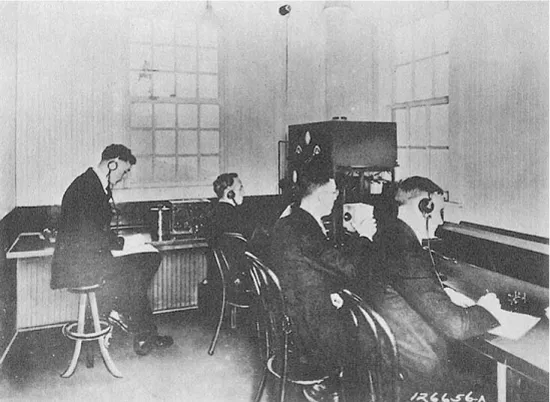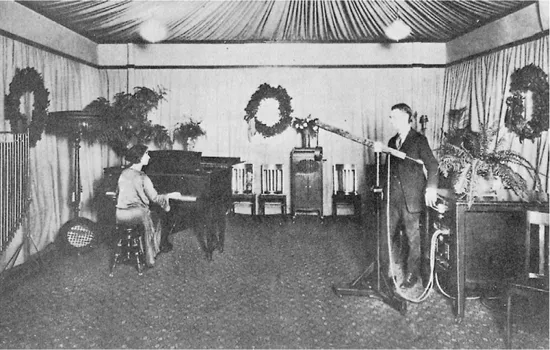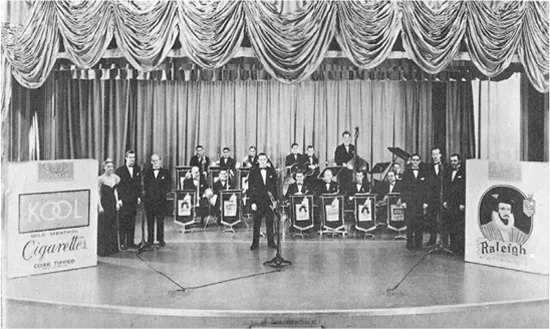![]()
1 | The History of Programming |
In this chapter you will learn about the following:
• Early radio and television programming strategies
• Advertising’s relationship to programming through the years
• The golden age of network radio programming and the effect the introduction of television had on radio
• The switch from advertiser-controlled to network-controlled programming
• The legacy of the golden age of television
• Cable and satellite television’s effect on programming
• What future programmers need to know about the cyclical nature of programming
• The influence of shorter audience attention spans, interactive content, and new technologies on current programming
• Major trends and developments in programming
• The effect of global markets and government regulations on programming
THE NEED FOR PROGRAMMING
Broadcast media has an insatiable appetite for programming content. With ever more distribution outlets available in the mediums of radio, television, and now the Internet, the demands of the marketplace continue to increase, with no end in sight to the quest for material.
With nearly 14,000 AM and FM radio stations broadcasting across the United States today, most of them 24-hour operations, simple math shows that stations must find a staggering 122,640,000 hours of material to air each year. Most of that material is new or original. Add to that the 100 channels that now broadcast 24 hours a day on two satellite radio services, and you get a sense of the appetite that radio alone has for program material.
In television, the National Broadcasting Company (NBC), which began televised broadcasts April 30, 1939, aired 601 hours of programming in its first year.1 Forty years later, in 1979, the number of hours NBC was airing per year had risen to 5,000.2 With the explosion of cable and satellite television services and the subsequent increase in the number of channels available, as well as the adoption of year-round original programming, the need for material continues its dramatic rise.
Now, enter the Internet, with theoretically limitless storage and delivery capacity. With a steadily growing number of consumers possessing broadband Internet connections, a new pipeline and hunger for audio, video, and interactive programming is coming online.
Figure 1.1 KDKA in Pittsburgh launched its radio programming on November 2, 1920, with this broadcast of the Warren Harding–James Cox election results. (Photo courtesy Westinghouse Broadcasting Company.)
All the available outlets clamor for product. Where does all this programming come from, and how does it find its way to an increasingly elusive and fragmented audience?
This chapter provides a brief history of radio, television, and Internet programming. In our quest to demystify programming, we examine early programming strategies and describe some of the major developments and trends that affect programming today. We do not seek to provide a complete history of radio, television, and Internet broadcasting here, but rather to provide examples of some key programming cycles and strategies. Because broadcast media programming is in constant flux, it is important to have a sense of the past to understand the present and anticipate the future.
THE EARLY DAYS OF PROGRAMMING
Early radio did not have programming departments. The novelty of the medium was exciting enough that people would stay glued to their earphones and huge battery-operated sets just to “hear Pittsburgh,” that is, hear the call letters and phonograph music coming from station KDKA in Pittsburgh (Figure 1.1), generally regarded as the first radio station.
The early stations were supported primarily by companies that manufactured and sold radio sets, and they programmed whatever free talent wandered into the studio. For most stations, this included a preponderance of would-be operatic sopranos. The goal was to have something on the air to encourage people to buy radios. Eventually, the novelty of radio wore off and performers wanted to be paid, so some economic means of supporting radio had to be found.
American Telephone and Telegraph (AT&T) hit upon an economic idea based on its telephone experience. It established station WEAF as a
toll station. People would be required to pay a toll to broadcast some message to all radio listeners in the same way that they paid a toll to send a private message from a phone booth. The company built a studio about the size and shape of a phone booth and waited for people to come and pay to send their messages. No one did. After a long struggle, WEAF, in August 1922, finally sold its first message, a 10-minute announcement from a Long Island real estate company that paid
50.
Even after this initial commercial, advertising was not viewed as a primary source of income for broadcasting. Herbert Hoover, who was Secretary of Commerce during the 1920s, said that “ether advertising” was possible, but he quickly dismissed the idea. “It is inconceivable that we should allow so great a possibility for service to be drowned in advertising chatter,” he said.3
But the production of radio material wasn’t going to pay for itself. As producers innovated the medium with live music, drama, complicated sound effects, up-to-date news gathering, and even unnecessary elaborate sets (Figure 1.2), the quality of radio programming improved and the expense increased.
Figure 1.2 KFI, Los Angeles’s first radio station, which began broadcasting in 1922, had this rather elaborate studio. Most early studios, although unseen by the listening audience, had elaborate decors that included potted palms, common foliage of the 1920s. (Photo courtesy KFI.)
Bringing in more income could be accomplished by bringing in more advertising. But as late as 1930, by which time the airwaves were drenched with advertising, the industry was still professing its commercial virginity. Before a Senate committee, Merlin Aylesworth, president of NBC, testified, “I am opposed to direct advertising on the air.” When a senator asked him what he meant by direct advertising, he replied, “I mean stating prices.”4 The following year that distinction fell by the wayside as advertising established itself as the means to keep radio growing.
There was a limit, though, to how much advertising the listening public could stomach. Somehow the industry would have to find a way to stretch its resources further.
THE BEGINNING OF NETWORK PROGRAMMING: A NEW LEASE FOR RADIO
The answer the radio industry came up with to maximize its resources was the network. The network system involved producing programs that could be used by a number of stations, thus reducing the cost for each station. Wires could carry the signal of the program produced in New York, networking it to stations in Boston, Philadelphia, Washington, and beyond. The first network to be established was NBC, which in 1926 broadcast its debut program (an orchestra from New York, a singer from Chicago, comedian Will Rogers from Kansas City, and dance bands from other cities) to 22 local stations.
Radio’s Golden Age: The Advertising Agency Years
When NBC was formed, it purchased WEAF from AT&T and continued a variation of the toll station concept, wherein advertising agencies bought blocks of time for their clients and filled this time with programming and mentions of the sponsor and of its product line. Sometimes the product became part of the story line—the announcer would visit Fibber McGee and Molly and talk about waxing the floor with Johnson’s Wax.
The advertisers and their agencies made almost all of the programming decisions, keeping top-level radio network executives informed as needed. The advertisers came up with the concepts, hired the talent, and oversaw the production (Figure 1.3). The networks provided the facilities for distributing the programming around the country. Of course, the advertisers paid the networks for these services.
Under this arrangement, the networks did little programming decision making. As long as the advertiser was happy with the program and its time slot and the material conformed to the network’s standards and policies, it was left alone. The networks distributed the programs and collected their money. As a result, many programs aired on radio for years in the same time slot. Jack Benny was on radio from 1932 until the mid-1950s at 7:30 Sunday evening. For much of his reign, he was sponsored by Jell-O. George Burns and Gracie Allen were on from 1933 to 1951, primarily sponsored by Robert Burns cigars. Dramas, comedies, children’s programs, soap operas—all were handled by advertising agencies. The only exception was news, which the networks produced and controlled.
The stability of this system led to what is often referred to as the golden age of radio. Radio listeners loyal to this exciting new medium tuned in unfailingly to their favorite shows. Writers and performers rose to the challenges of entertaining this rapt audience and, with shows continuing for years, were able to constantly add to and modify the formula of their craft. The golden age of radio also allowed unprecedented events to be staged across the country, uniting individuals in the nation unlike any other media ever had before. The most striking of these events occurred in 1938, when Orson Welles’ exceedingly realistic radio adaptation of H. G.Wells’s 1898 novel War of the Worlds aired. Under Welles’ direction, the play was performed and written so that it would sound like a real news broadcast of an invasion of the Earth by Martians. A short notice that the production was fiction played at the beginning of show, not repeated again until nearly 40 minutes into the show. The broadcast created mass, if not universal, panic. Streets were packed with panicked radio listeners, people hid in cellars and loaded guns, and some even wrapped their heads in wet towels as protection from poisonous Martian gas.
Figure 1.3 The Tommy Dorsey Band was obviously sponsored by cigarettes. Although the home audience couldn’t see them, the enlarged cigarette boxes were prominently placed on stage. Because this program was performed before a live audience, the sponsor’s product was constantly seen by the studio audience. (Photo courtesy KFI.)
This was the power and reach of the radio networks into people’s lives. Because most stations of the day were affiliated with one of the four networks (NBC, CBS, ABC, or the ill-fated Mutual Broadcasting System), stations mostly transmitted network programming with scant locally produced material. The little the individual stations produced on their own was mainly of a public service or phonograph music nature.
THE INTRODUCTION OF TELEVISION AND ITS EFFECT ON RADIO
When television broadcasting started to take off in the late 1940s and early 1950s, television producers adopted the network programming methods used in radio. Once again, advertising agencies provided programs and paid for them in their entirety—such as “Philco Television Playhouse,” “Kraft Television Theater,” and “Texaco Star Theater.” TV adopted not only the programming process of radio but also its stars and advertisers.
Numerous radio programs made the transition to television, where they successfully established themselves—many becoming some of early television’s favorite shows. The list of transfers from radio to the medium that featured both sight and sound is a long one (Figure 1.4).
Television’s early duplication of radio shows caused radio to take a downturn. Newer and engaging audiences in both sight and sound, television siphoned off radio listeners, giving credence to the fears radio harbored about the threat of television.
While radio was floundering, television was experimenting with its potential. Not content to merely have television become “radio with pictures,” early television pioneers, such as Leonard Goldenson, who founded the American Broadcasting Company (ABC) in 1953, sought to make television unique from radio. Goldenson wanted to emphasize television as a visual medium and sought a movie format instead of a radio format. In his autobiography, aptly titled Beating the Odds, he describes his plan: “We would put programs on film and show them on the network the same way we showed feature films in theaters.”5 In so doing, he looked to Hollywood for inspiration instead of New York, where radio had been king.
Figure 1.4 Included here are some programs that transferred from radio to television during the early days of television, illustrating how radio supplied television with some of the new medium’s signature programming. The first date indicates when the program appeared on television; the second date shows when it started on radio.
ABC had Goldenson as its visionary in the early days. He was not alone, however, in seeing the potential that television offered. The Columbia Broadcasting System (CBS) had the legendary William Paley whose vision and impeccable taste helped him turn CBS into the “Tiffany” network, a s...





